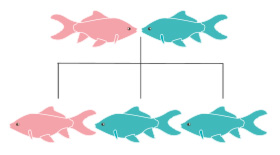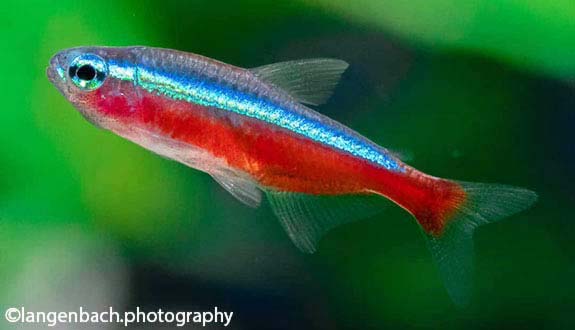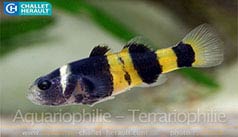

Alternative species (click on the thumbnail to see the card)
Names
Scientific name
Paracheirodon axelrodi
Hyphessobrycon cardinalis
Cheirodon axelrodi
Hyphessobrycon cardinalis
Common name
Cardinal tetra
Large neon tetra
Red neon
Roter neon
Origin

Origin: Brazil (Rio Negro) and Venezuela (tributaries of the Orinoco)
Biotope: Amazonian
Dimorphism

The female is more bouncy and larger than the male.
Group

Characidae
Volume

80 L / 18 Imp Gal / 21 US Gal
Parameters

T°: 25 to 27°C or 77 to 81°F
pH: 5 to 5
Hardness: 5 to 12°dGH
Difficulty

Easy
Size

4 to 5cm (1.6 to 2")
Longevity

2 to 3 years
Living zone

Middle
Individuals

10
Food
How to feed the Cardinal tetra?
Food
How to feed the Cardinal tetra?
Feeding the Cardinalis won't really be a problem. As omnivores, they will accept any form of food that is offered. However, vary its meals for better health and colouring. Especially since it really appreciates live (or frozen) prey such as artemia and bloodworms.
Behavior
What kind of behavior does the Cardinal tetra have?
Behavior
What kind of behavior does the Cardinal tetra have?
This species is particularly gregarious, likes to swim in shoals. This instinct comes from its natural environment where it has many predators. To protect themselves, they all form huge shoals of thousands of individuals. In captivity, he retains the same instinct. They therefore adopt a "normal" behaviour from 10 or more individuals, and this is the strict minimum for their well-being. They display all their splendour from 30 specimens (you will then need a 250-litre aquarium). You will then see them swimming in close rows (the more numerous they are and the more compact the bench is), very close to their natural behaviour.
Cohabitation
Who can live with the Cardinal tetra?
Cohabitation
Who can live with the Cardinal tetra?
Very sociable and peaceful, Cardinalis are the perfect fish for community aquariums.
However, beware of predation by large fish such as Scalarias or Discus that do not refuse to eat a Cardinalis from time to time.
Breeding
How to breed the Cardinal tetra?
Breeding
How to breed the Cardinal tetra?
Very difficult. For one thing, Cardinalis rarely spawn in summer. Instead, the breeding season is from October to April. What makes this reproduction difficult is that atmospheric conditions play a role in triggering spawning (the increase in atmospheric pressure stimulates spawning), a parameter that is difficult to control!
Prepare a breeding aquarium of about 20 litres (4 Imp Gal / 5US Gal. The water should be acidic (pH 5/5.5) and very soft. Set the temperature at 24/28°C (75/82°F). Use osmosis water and peat plates for this. Sieve the walls of the aquarium to make it opaque (the fry are afraid of light). Finally, place a few tufts of Java moss and strands of Myriophyllum.
Isolate a couple that you will stimulate for spawning by feeding them live prey (Grindal worms, daphnia...). They will first have to get used to this new environment before spawning. This is why you should be patient as it will take several days before they reproduce. Spawning is often nocturnal, before sunrise (possibility in the evening but it is rarer).
The eggs are laid in open water and measure only 0.8 mm. Remove the breeding pair after spawning. Incubation will last from 18 to 24 hours. Free swimming will be possible 3 to 4 days later. The fry starting to swim remain close to the bottom of the aquarium, they are fearful and difficult to see, especially as at this stage they are still deprived of light!
The fry are very fragile and sensitive to the quality of their water. Accustom them very gently to the water in the main aquarium by making regular small additions of this water.
As they grow, gently bring the light back into the aquarium.
Feeding the fry: infusing and then feeding the young artemia nauplias. After 6 weeks, or when the fry are 1 cm long, offer cut-up tubifex. This tubifex-based diet allows for faster development.
Its aquarium
Which aquarium for the Cardinal tetra?
Its aquarium
Which aquarium for the Cardinal tetra?
In its natural environment, it lives close to the banks, in shallow water. In the Rio Negro (Brazil), they live in "black", acidic (5.5 or less) and rather soft water. You will certainly have recognized the criteria of an Amazonian biotope! In the Orinoco (Venezuela), the waters are clearer and more neutral (5.5/6.5), and the substratum is sand. These fish are therefore very adaptable.
To reproduce these conditions in captivity, filter on peat (for simulation of the Rio Negro only) and use osmosis water if necessary to obtain the right water parameters. For the scenery, use dark rocks and peat bog roots. Plant abundantly, especially on the sides and bottom of the aquarium to leave enough room for swimming. Plants will provide shaded areas, which are particularly popular with the species (these fish do not like bright light). Choose a dark substrate that will bring out their beautiful colouring even more. Finally, sprinkle the ground with dried tree leaves (oak, beech, catappa) or alder fruit.
Good To know
Find all additional information!
Good To know
Find all additional information!
There is a "platinium" or "gold" variety, which is perfectly natural! This variety has more or less abundant metallic or gold scales. There is also an albino variety of this species.
This species is very close to the Blue Neon (Paracheirodon innesi). The difference between its two species is the luminescent blue band that runs the entire length of the fish for the Cardinalis, while this line stops well before the caudal fin in the Blue Neon.
Unlike many ornamental fish sold today, the representatives of this species are mostly caught in their natural environment. As a result, they are still quite sensitive to water quality and pollution, and often weakened by their long journey. It is not uncommon for them to declare white spots as soon as they arrive in your area. Pay attention to acclimatization, which should be very gentle, and avoid stress as much as possible.
Yours photos!

By Encyclo-Caro

By Encyclo-Caro
Comments
Sort by:
Please login to post comments


